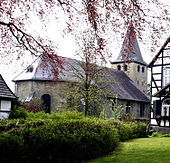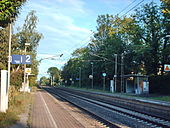Borrowing
|
Borrowing
Welver parish
Coordinates: 51 ° 36 ′ 2 ″ N , 8 ° 2 ′ 14 ″ E
|
|
|---|---|
| Height : | 81 m |
| Area : | 6.66 km² |
| Residents : | 1069 (Jan 1, 2009) |
| Population density : | 161 inhabitants / km² |
| Incorporation : | 1st July 1969 |
| Postal code : | 59514 |
| Area code : | 02921 |
Borgeln is a district of the municipality Welver in the district of Soest in North Rhine-Westphalia .
location
Borgeln is located between the towns of Soest and Hamm on the L 670 road and on the Hamm – Soest railway line , where Borgeln train station was opened in 1880. Borgeln includes the boroughs Borgeler Linde, the farms of Fahnen, Gut Broel and the farms "Am Kotten ".
history
Borgeln may have already been in 1160 with respect to the year 1021 as Burclaun mentioned, but surely in 1166 as Burgelon (along with the forest Broil in the immediate area). Archbishop Reinald of Cologne sold a forest called Broil to the knight Helmwig von Holthusen as an interest loan. The origin of the place name is relatively undisputed: the first part can be traced back to a castle or fortified dwelling (Borg in Low German), the second part relates to the common word “Loh” (forest). The place name means something like: "near the castle forests". Street names such as on the Borg, on the Borgweide or Borggraben refer to this meaning. The Burgplatz included the Wortmannshof, the Schwollenhof, the Bertelshof and the Bertelskotten. These courtyards are located on a ridge sloping down on three sides, which only required an artificial weir on one side. The castle was probably the ancestral seat of the milites de Burgelen . This knightly family was mentioned in Soest documents for about 200 years from 1250. Although the city of Soest their gogerichtliche goal for jurisdiction since the 12th century and the parish Borgeln under the sovereignty of Soest Patrokli pen was, was Borgeln part of Franche Rüdenberg . When Gottfried von Rüdenberg acquired the Free County of Rüdenberg in Soest in 1328, Borgeln came under the control of the city of Soest and was part of the Niederbörde until 1807/09 . According to Hubertus Schwartz , the Romanesque church in Borgeln from 1050 is “the oldest sacred building on the Soest Börde ”. North of the church is the listed rectory , a half-timbered building from 1800.
In the witch hunts from 1577 to 1604 ten cases of witchcraft and sorcery are documented. Eight people were executed in the witch trials and two more died in prison.
On July 1, 1969 Borgeln was incorporated into Welver.
Attractions
In the list of architectural monuments in Welver , nine architectural monuments from Borgeln are listed.
Personalities
Sons and daughters of the place
- Patroclus Römeling (* around 1481 in Borgeln; † April 1571 in Diepholz ), Protestant theologian and reformer
- Heinrich Poetter (born January 26, 1830; † 1918 in Lichterfelde near Berlin ), Protestant theologian and general superintendent of the Church Province of Pomerania
- Adolf Clarenbach (born July 12, 1877 in Borgeln; † 1952), superintendent, local researcher and honorary citizen of Soest
Persons connected with Borgeln
- Franz Nölken (born May 5, 1884 in Hamburg, † November 4, 1918 in La Capelle , Aisne, France), German expressionist painter, worked for a while in Borgeln
literature
- Adolf Clarenbach: Bibliography on the villages and farms of the parish Borgeln . Soest 1934.
- Parish Borgeln (ed.): Reformation events in the parish Borgeln. 1483 1533 1583 1933 1983 . Soest 1983.
- Heinrich Weimann: Attempt of a chronicle of Borgeln . Soest 1887.
Web links
- borgeln.de
- Welver parish
- On the history of extinguishing in Borgeln and the surrounding area
- Working group Heimatvereine and Ortsheimatpfleger Welver, page about Borgeln
Individual evidence
- ↑ Burclaun can also refer to the Borchler desert near Paderborn, cf. for discussion: Michael Flöer, Claudia Maria Korsmeier: The place names of the Soest district (= Westphalian Place Name Book (WOB), Volume 1). Publishing house for regional history, Bielefeld 2009, ISBN 978-3-89534-791-7 , p. 82 ( digitized version ).
- ^ Michael Flöer, Claudia Maria Korsmeier: The place names of the Soest district (= Westphalian Place Name Book (WOB), Volume 1). Publishing house for regional history, Bielefeld 2009, ISBN 978-3-89534-791-7 , p. 83 ( digitized version ).
- ^ A. Ludorf: Die Bau- und Kunstdenkmäler von Westfalen, published by the Provinzial-Verbande der Provinz Westfalen, 1905, p. 9
- ↑ borgeln.de
- ^ Georg Dehio : Handbook of German Art Monuments, North Rhine-Westphalia, Volume 2, Westphalia, Deutscher Kunstverlag, Munich 1969, p. 68
- ↑ Martin Bünermann: The communities of the first reorganization program in North Rhine-Westphalia . Deutscher Gemeindeverlag, Cologne 1970, p. 92 .
- ↑ clarenbachschule.de



